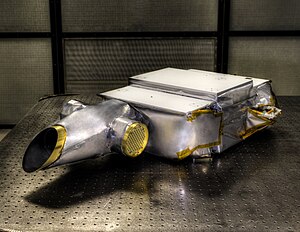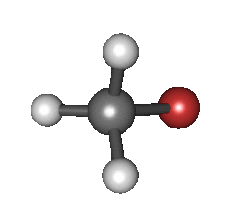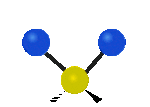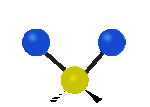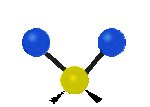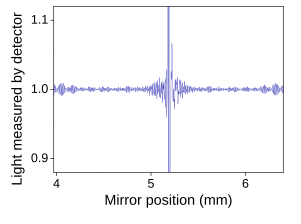Infrared spectroscopy
infrared spectroscopy (spectroscopy IR or spectroscopy vibrational) is the measure of the interaction of infrared radiation with matter by absorption, emission, or reflection. It is used to study and identify chemical substances or functional groups in solid, liquid or gaseous form. The method or technique of infrared spectroscopy is performed with an instrument called an infrared spectrometer (or spectrophotometer) that produces an infrared spectrum . An infrared spectrum can be displayed on a graph of absorbance (or transmittance) of infrared light on the vertical axis versus frequency or wavelength on the horizontal axis. Typical units of frequency used in infrared spectra are reciprocal centimeters (sometimes called wave numbers), with the symbol cm-1. Units of IR wavelength are commonly given in micrometers (formerly called "microns"), symbol μm, which are related to the wavenumbers reciprocally. A common laboratory instrument that uses this technique is a Fourier Transform Infrared (FTIR) spectrometer. Two-dimensional IR is also possible.
The infrared portion of the electromagnetic spectrum is generally divided into three regions; near, mid and far infrared, named for its relationship to the visible spectrum. The higher energy near-infrared, approximately 14000–4000 cm−1 (0.7–2.5 μm wavelength) can excite harmonic or combined modes of molecular vibrations. The mid-infrared, approximately 4000–400 cm−1 (2.5–25 μm) is generally used to study fundamental vibrations and associated rotational-vibrational structure. Far infrared, approximately 400-10 cm−1 (25-1000 μm) is low energy and can be used for rotational spectroscopy and low frequency vibrations. The 2-130 cm−1 region, bordering the microwave region, is considered the terahertz region and can probe intermolecular vibrations. The names and classifications of these subregions are conventions, and are based on only vaguely in the relative molecular or electromagnetic properties.
Theory
Infrared spectroscopy takes advantage of the fact that molecules absorb frequencies characteristic of their structure. These absorptions occur at resonant frequencies, that is, the frequency of the absorbed radiation coincides with the vibrational frequency. The energies are affected by the shape of the molecular potential energy surfaces, the masses of the atoms, and the associated vibronic coupling.
In particular, in the Born-Oppenheimer and harmonic approximations, that is, when the molecular Hamiltonian corresponding to the electronic ground state can be approximated by a harmonic oscillator in the neighborhood of the equilibrium molecular geometry, the resonance frequencies are associated with the normal modes of vibration corresponding to the potential energy surface of the molecular electronic ground state. Resonant frequencies are also related to the strength of the bond and the atomic mass at each end of the bond. Therefore, the frequency of the vibrations is associated with a particular normal motion mode and a particular link type.
Number of vibrational modes
For a vibrational mode in a sample to be "IR active", it must be associated with changes in dipole moment. A permanent dipole is not necessary, as the rule only requires a change in dipole moment.
A molecule can vibrate in many ways, and each of them is called vibratory mode. For molecules with N{displaystyle {ce {N}}} Number of atoms, linear molecules have 3N - 5 degrees of vibrational modes, while nonlinear molecules have 3N - 6 degrees of vibrational modes (also called degrees of vibrational freedom). As an example, the H2O{displaystyle {ce {H2O}}}, a nonlinear molecule, will have 3 × 3 - 6 = 3 degrees of vibratory freedom or modes.
Simple diatomic molecules have only one link and only one vibratory band. If the molecule is symmetrical, for example, N2{displaystyle {ce {N2}}}, the band is not seen in the IR spectrum, but only in the Raman spectrum. Asymmetric diatomic molecules, for example CO, are absorbed in the IR spectrum. The most complex molecules have many links and their vibrational spectra are correspondingly more complex, i.e. large molecules have many peaks in their IR spectrums.
Atoms of a group CH2X2{displaystyle {ce {CH2X2}}}}which are commonly found in organic compounds and where X{displaystyle {ce {X}}} can represent any other atom, can vibrate in nine different ways. Six of these vibrations involve only the portion of CH2: two modes stretch (i) symmetrical (woman)s) and antisimetric (woman)aand four modes bending: Scissors (δ), balance (ρ) mellow (ω) and torque (τ), as shown below. The structures that do not have the two groups X{displaystyle {ce {X}}} additional attachments have less modes because some modes are defined by specific relationships with those other attachments. For example, in the water, the modes of balance, meneo and torsion do not exist because these types of movements of H atoms represent a simple rotation of the entire molecule instead of vibrations within it. In the case of more complex molecules, vibrational modes may also be present outside the plane (γ).
These figures do not represent the "retroces" of the atoms of C{displaystyle {ce {C}}which, although they are necessarily present to balance the general movements of the molecule, are much smaller than the movements of the atoms of H{displaystyle {ce {H}}} lighter.
Special effects
The simplest and most important IR bands fundamental fundamental arise from the excitations of normal modes, the simplest distortions of the molecule, from the fundamental state with vibratory quantum number v=0{displaystyle v=0} until the first excited state with vibratory quantum number v=1{displaystyle v=1}. In some cases, harmonic bands are observed. A harmonic band emerges from the absorption of a photon that leads to a direct transition from the fundamental state to the second excited vibratory state (v=2{displaystyle v=2}). Such band appears approximately to twice the energy of the fundamental band for the same normal mode. Some excitations, the so-called combination modes, imply the simultaneous excitation of more in a normal way. The phenomenon of Fermi resonance may arise when two modes are similar in energy; Fermi resonance results in an unexpected change in the energy and intensity of the bands, etc.
Practical IR Spectroscopy
The infrared spectrum of a sample is recorded by passing a beam of infrared light through the sample. When the IR frequency is the same as the vibrational frequency of a link or collection of links, absorption occurs. Examination of the transmitted light reveals how much energy was absorbed at each frequency (or wavelength). This measurement can be achieved by scanning the wavelength range using a monochromator. Alternatively, the entire wavelength range is measured using a Fourier transform instrument and then a transmittance or absorbance spectrum is generated using a dedicated procedure.
This technique is commonly used to analyze samples with covalent bonds. Simple spectra are obtained from samples with few IR active bindings and high levels of purity. More complex molecular structures lead to more absorption bands and more complex spectra.
Sample preparation
Gas samples
Gas samples require a sample cell with a long path to compensate for dilution. The length of the sample cell pathway depends on the concentration of the compound of interest. A single glass tube with a length of 5 to 10 cm equipped with transparent infrared windows at both ends of the tube can be used for concentrations of several hundred ppm. Sample gas concentrations less than 1 ppm can be measured with a White cell in which infrared light is guided by mirrors to travel through the gas. White cells are available with an optical path length from 0.5 m to one hundred meters.
Liquid samples
Liquid samples can be sandwiched between two plates of a salt (commonly sodium chloride or table salt, although various other salts, such as potassium bromide or calcium fluoride, are also used). The plates are transparent to light. infrared and do not introduce lines in the spectra.
Solid samples
Solid samples can be prepared in a variety of ways. A common method is to grind the sample with an oily grinding agent (usually Nujol mineral oil). A thin film of mull is applied to salt plates and measured. The second method is to finely grind a quantity of the sample with a specially purified salt (usually potassium bromide) (to eliminate the scattering effects of large crystals). This powder mixture is then pressed in a mechanical press to form a translucent pellet through which the spectrometer beam can pass. A third technique is the "cast film", which is mainly used for polymeric materials. The sample is first dissolved in a non-hygroscopic solvent. A drop of this solution is deposited on the surface of the KBr or NaCl cell. The solution is then evaporated to dryness and the film formed in the cell is analyzed directly. It is important to take care to ensure that the film is not too thick, otherwise light cannot pass through. This technique is suitable for qualitative analysis. The last method is to use a microtomy to cut a thin film (20-100 μm) from a solid sample. This is one of the most important ways to analyze defective plastic products, for example, because the integrity of the solid is preserved.
In photoacoustic spectroscopy, the need for sample treatment is minimal. The sample, liquid or solid, is placed in the sample cup which is inserted into the photoacoustic cell which is then sealed for measurement. The sample can be a solid piece, a powder, or basically any form for measurement. For example, a piece of rock can be inserted into the sample cup and the spectrum measured.
Comparing with a reference

It is typical to record the spectrum of both the sample and a "reference". This step controls a number of variables, eg an infrared detector, that can affect the spectrum. The reference measurement allows to eliminate the influence of the instrument.
The "reference" appropriate depends on the measurement and its objective. The simplest reference measurement is simply to remove the sample (replacing it with air). However, sometimes a different reference is more useful. For example, if the sample is a dilute solute dissolved in water in a beaker, a good reference measurement might be to measure pure water in the same beaker. So the reference measurement would cancel out not only all instrumental properties (such as the light source being used), but also the light-absorbing and reflecting properties of the water and the beaker, and the end result would only show the properties of the solute (at least approximately).
A common way to compare to a reference is sequentially: first measure the reference, then replace the reference with the sample, and measure the sample. This technique is not perfectly reliable; If the infrared lamp is a little brighter during reference measurement, then a little dimmer during sample measurement, the measurement will be distorted. More elaborate methods, such as a "two beam" (see figure), they can correct this type of effects to give very precise results. The standard addition method can be used to statistically cancel out these errors.
However, among the different absorption-based techniques used for the detection of gaseous species, cavity ring spectroscopy (CRDS) can be used as a calibration-free method. The fact that CRDS is based on photon lifetime measurements (and not laser intensity) means that no calibration and comparison to a reference is necessary.
FTIR
Fourier Transform Infrared Spectroscopy (FTIR) is a measurement technique that makes it possible to record infrared spectra. Infrared light is guided through an interferometer and then through the sample (or vice versa). A moving mirror inside the apparatus alters the distribution of infrared light that passes through the interferometer. The directly recorded signal, called an 'interferogram', represents the light output as a function of mirror position. A data processing technique called a Fourier transform converts this raw data into the desired result (the spectrum of the sample): Light output as a function of infrared length (or equivalently, wavenumber). As described above, the sample spectrum is always compared to a reference.
An alternative method for acquiring spectra is the "dispersive" or "scanning monochromator" method. In this approach, the sample is irradiated sequentially with several single wavelengths. The dispersive method is more common in UV-VIS spectroscopy, but it is less practical in the infrared than the FTIR method. One reason why FTIR is favored is called the "Fellgett advantage" or "multiplexing advantage": the information in all frequencies are collected simultaneously, improving both speed and signal-to-noise ratio. Another is called the "Jacquinot Performance Advantage": a dispersive measurement requires detecting much lower light levels than an FTIR measurement. There are other advantages, as well as some disadvantages, but virtually all modern infrared spectrometers are FTIR instruments.
Infrared microscopy
There are several forms of infrared microscopy. These include IR versions of sub-diffraction microscopy such as IR NSOM, photothermal microspectroscopy, Nano-FTIR, and atomic force microscope-based infrared spectroscopy (AFM-IR).
Other methods in molecular vibrational spectroscopy
Infrared spectroscopy is not the only method of studying molecular vibrational spectra. Raman spectroscopy involves an inelastic scattering process in which only part of the energy of an incident photon is absorbed by the molecule and the remaining part is scattered and detected. The energy difference corresponds to the absorbed vibrational energy. The selection rules for infrared and Raman spectroscopy are different for at least some molecular symmetries, so the two methods are complementary in the sense that they observe vibrations of different symmetries.
Another method is electron energy loss spectroscopy (EELS), in which the absorbed energy is provided by an inelastically scattered electron instead of a photon. This method is useful to study the vibrations of molecules adsorbed on a solid surface.
Recently, High Resolution EELS (HREELS) has emerged as a technique for performing vibrational spectroscopy in a transmission electron microscope (TEM). Combined with the high spatial resolution of TEM, unprecedented experiments have been performed, such as nanoscale temperature measurements, mapping of isotopically labeled molecules, mapping of phonon modes in position and momentum, vibrating surface and volume mode mapping in nanocubes, and investigations of polariton modes in van crystals. der Waals. Analysis of vibrational modes that are IR-inactive but appear in inelastic neutron scattering is also possible at high spatial resolution using EELS. Although the spatial resolution of HREELs is very high, the bands are extremely wide. compared to other techniques.
Computational Infrared Microscopy
By using computer simulations and normal mode analysis, it is possible to calculate theoretical frequencies of molecules.
Absorption bands
IR spectroscopy is often used to identify structures because functional groups give rise to characteristic bands both in terms of intensity and position (frequency). The positions of these bands are summarized in correlation tables as shown below.
Regions
A spectrograph is often interpreted as having two regions.
- region of the functional group ≥ ≥ 1500cm− − 1{displaystyle geq 1500 cm^{-1}
In the functional region there are one to a few channels per functional group.
- region fingerprint or fingerprints<math alttext="{displaystyle .1500cm− − 1{displaystyle ≥1500~cm^{-1}}<img alt="{displaystyle
In the fingerprint region there are many channels that form an intricate pattern that can be used like a fingerprint to determine the compound.
Badger's Rule
For many types of samples, the assignments are known, that is, which bond strains are associated with which frequency. In such cases, more information about the strength of a link can be obtained, based on the empirical guideline called Badger's Rule. Originally published by Richard McLean Badger in 1934, this rule states that the strength of a bond (in terms of force constant) is correlated with the length of the bond. That is, the increase in the strength of the joint leads to the corresponding shortening of the joint and vice versa.
Uses and applications
Infrared spectroscopy is a simple and reliable technique widely used in organic and inorganic chemistry, in research and industry. It is used in quality control, dynamic measurement and monitoring applications, such as long-term unsafe measurement of concentrations CO2{displaystyle {ce {CO2}}} in greenhouses and growth chambers through infrared gas analyzers.
It is also used in forensic analysis in criminal and civil cases, for example, to identify the degradation of polymers. It can be used to determine the blood alcohol content of a suspected drunk driver.
IR spectroscopy has been used successfully in the analysis and identification of pigments in paintings and other art objects such as illuminated manuscripts.
A useful way to analyze solid samples without the need to cut samples uses ATR or attenuated total reflectance spectroscopy. With this approach, samples are pressed against the face of a single crystal. Infrared radiation passes through the crystal and only interacts with the sample at the interface between the two materials.
With the increase in technology in computer filtering and manipulation of results, samples in solution can now be accurately measured (water produces a wide absorbance in the range of interest and therefore does that the spectra are illegible without this computer processing).
Some instruments also automatically identify the substance being measured from a store of thousands of stored reference spectra.
Infrared spectroscopy is also useful for measuring the degree of polymerization in polymer manufacturing. Changes in the character or amount of a particular link are assessed by measuring at a specified frequency over time. Modern research instruments can take infrared measurements in the range of interest as often as 32 times per second. This can be done while making simultaneous measurements using other techniques. This makes observations of chemical reactions and processes faster and more accurate.
Infrared spectroscopy has also been used successfully in the field of semiconductor microelectronics: for example, infrared spectroscopy can be applied to semiconductors such as silicon, gallium arsenide, gallium nitride, zinc selenide, amorphous silicon, silicon nitride, etc.
Another important application of infrared spectroscopy is in the food industry to measure the concentration of various compounds in different food products
Instruments are now small and portable, even for use in field tests.
Infrared spectroscopy is also used in gas leak detection devices such as the DP-IR and EyeCGA. These devices detect hydrocarbon gas leaks in the transportation of natural gas and crude oil.
In February 2014, NASA announced a greatly improved database, based on IR spectroscopy, for tracking polycyclic aromatic hydrocarbons (PAHs) in the universe. According to scientists, more than 20% of the carbon in the universe may be associated with PAHs, possible starting materials for the formation of life. PAHs appear to have formed shortly after the Big Bang, are widespread throughout the universe, and are associated with new stars and exoplanets.
Recent developments include a miniature IR spectrometer that is linked to a cloud-based database and is suitable for personal daily use, and NIR spectroscopic chips that can be embedded in smartphones and various devices.
Isotope effects
Different isotopes in a particular species can display different fine details in infrared spectroscopy. For example, it is experimentally determined that the stretch rate O− − O{displaystyle {ce {O-O}}} (in reciprocal centimeters) of oxi hemocianine is 832 and 788 cm −1 for v{displaystyle v} (O16− − 16{displaystyle {ce {^{16}O-^{16}}}}}}O{displaystyle {ce {O}}}) and v{displaystyle v} (O18− − 18O{displaystyle {ce {^{18}o-^{18}o}o}}}}), respectively.
When considering the link O− − O{displaystyle {ce {O-O}}} like a spring, the absorbance frequency can be calculated as a wave number [= frequency/(light rate)]
.. =12π π ckμ μ {displaystyle nu ={frac {1}{2pi c}}{sqrt {frac {k}{mu }}}}}}}{sqrt {frac {f}{f}}}}}}}}
where k is the spring constant for the link, c is the speed of light and μ is the reduced mass of the system A− − B{displaystyle {ce {A-B}}}:
μ μ =mAmBmA+mB{displaystyle mu ={frac {m_{A}m_{B}}}{m_{A+}m_{B}}}}}
(mi{displaystyle m_{i}} is the mass of the atom i{displaystyle i}).
The masses reduced to O16− − 16{displaystyle {ce {^{16}O-^{16}}}}}}O{displaystyle {ce {O}}} and O18− − 18O{displaystyle {ce {^{18}o-^{18}o}o}}}} can be approx. 8 and 9 respectively. So.
.. (16O).. (18O)=98≈ ≈ 832788.{displaystyle {frac {nu(^{16}O)}{nu (^{18}}}}}}}{sqrt {frac {9}{8}}{8}}}}}approx {frac {832}{788}}}}}}}.
where .. {displaystyle nu } is the wave number; [wave number = frequency/(light rate)]
It has been discovered that the effect of isotopes, both in vibration and in the dynamics of disintegration, is stronger than thought. In some systems, such as silicon and germanium, the disintegration of the antisimetric stretch mode of interstitial oxygen involves the symmetrical stretch mode with a strong dependency of isotopes. For example, it was shown that for a sample of natural silicon, the useful life of the antisimetric vibration is 11.4 ps. When the isotope of one of the silicon atoms increases to Yeah.29{displaystyle {ce {cHFFFF}{cH00}}}, useful life increases to 19 ps. Similarly, when the silicon atom changes to Yeah.30{displaystyle {ce {cHFF}{cH00}}}, useful life becomes 27 ps.
2-dimensional IR
Two-dimensional infrared correlation spectroscopy analysis combines multiple samples of infrared spectra to reveal more complex properties. By extending the spectral information of a disturbed sample, spectral analysis is simplified and resolution is improved. 2D synchronous and 2D asynchronous spectra represent a graphical description of the spectral changes due to a disturbance (such as a concentration or temperature change), as well as the relationship between the spectral changes at two different wavenumbers.
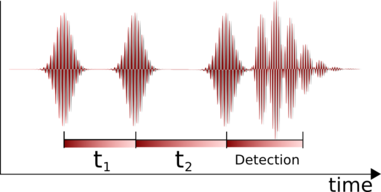
Nonlinear two-dimensional infrared spectroscopy is the infrared version of correlation spectroscopy. Nonlinear two-dimensional infrared spectroscopy is a technique that has become available with the development of femtosecond infrared laser pulses. In this experiment, a set of pump pulses is first applied to the sample. This is followed by a timeout during which the system is allowed to relax. The typical wait time is zero to several picoseconds, and the duration can be controlled with a resolution of tens of femtoseconds. A probe pulse is then applied, resulting in the emission of a signal from the sample. The nonlinear two-dimensional infrared spectrum is a two-dimensional correlation plot of the frequency ω1 that was excited by the initial pump pulses and the frequency ω3 excited by the pulse of the probe after the waiting time. This allows observing the coupling between different vibrational modes; Due to its extremely fine time resolution, it can be used to monitor molecular dynamics on a picosecond time scale. It is still a largely unexplored technique and is becoming increasingly popular for fundamental research.
As with two-dimensional nuclear magnetic resonance (2DNMR) spectroscopy, this technique extends the spectrum in two dimensions and allows the observation of cross-peaks that contain information about the coupling between different modes. In contrast to 2DNMR, nonlinear two-dimensional infrared spectroscopy also involves excitation of harmonics. These excitations result in excited state absorption peaks located below the diagonal and cross peaks. In 2DNMR, two different techniques, COZY and NOESY, are frequently used. The crossover peaks in the former are related to scalar coupling, while in the latter they are related to spin transfer between different nuclei. In nonlinear two-dimensional infrared spectroscopy, analogues of these 2DNMR techniques have been extracted. Nonlinear two-dimensional infrared spectroscopy with zero wait time corresponds to COSY, and nonlinear two-dimensional infrared spectroscopy with finite wait time that allows vibrational population transfer corresponds to NOESY. The COZY variant of non-linear two-dimensional infrared spectroscopy has been used for the determination of the secondary structure content of proteins.
Contenido relacionado
Appliance
Apple (disambiguation)
(66) Pestle
